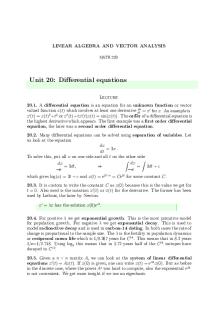Lecture 20 - Summary Teaching Mathematics PDF

| Title | Lecture 20 - Summary Teaching Mathematics |
|---|---|
| Author | Giulio Grillo |
| Course | Teaching Mathematics |
| Institution | Harvard University |
| Pages | 4 |
| File Size | 167.6 KB |
| File Type | |
| Total Downloads | 93 |
| Total Views | 151 |
Summary
Differential equations...
Description
LINEAR ALGEBRA AND VECTOR ANALYSIS MATH 22B
Unit 20: Differential equations Lecture 20.1. A differential equation is an equation for an unknown function or vector dx valued function x(t) which involves at least one derivative dt = x′ for x. An example is ′ 2 3 ′′ ′ x (t) = x(t) +t or x (t)+tx (t)x(t) = sin(x(t)). The order of a differential equation is the highest derivative which appears. The first example was a first order differential equation, the later was a second order differential equation. 20.2. Many differential equations can be solved using separation of variables. Let us look at the equation dx = 3x . dt To solve this, put all x on one side and all t on the other side: Z Z dx dx = 3dt + c = 3dt, ⇒ x x which gives log(x) = 3t + c and x(t) = e3t+c = Ce3t for some constant C . 20.3. It is custom to write the constant C as x(0) because this is the value we get for t = 0. Also used is the notation x′ (t) or x(t) ˙ for the derivative. The former has been used by Leibniz, the later by Newton. x′ = λx has the solution x(0)eλt . 20.4. For positive λ we get exponential growth. This is the most primitive model for population growth. For negative λ we get exponential decay. This is used to model radioactive decay and is used in carbon-14 dating. In both cases the rate of change is proportional to the sample size. The λ is the fertility in population dynamics or reciprocal mean life which is 1/8.267 years for C 14 . This means that in 8.2 years 1/e=1/2.718. Using log2 this means that in 5.72 years half of the C 14 isotopes have decayed to C 12. 20.5. Given a n × n matrix A, we can look at the system of linear differential equations x′ (t) = Ax(t). If x(0) is given, one can write x(t) = eAt x(0). But as before in the discrete case, where the power At was hard to compute, also the exponential eAt is not convenient. We get more insight if we use an eigenbasis.
Linear Algebra and Vector Analysis
Figure 1. The exponential function.
5 1 3 20.6. For example, for A = , we proceed and an initial condition like 4 2 4 exactly in the same way. We have already the eigenvectors v1 = [1, 1]T , v2 = [−1, 2]T to the eigenvalues λ1 = 6, λ2 = 3 and x = [3, 4]T is c1 v1 + c2 v2 with c1 = 10/3 and c2 = 1/3. The closed-form solution is 10 6t 1 1 3t −1 x(t) = e . + e 2 1 3 3 Also here, we have no problem evaluating this at any time t. If B = {v1 , · · · , vn } is an eigenbasis of A and x(0) = c1 v1 + · · · + cn vn then x(t) = c1 eλ1 t v1 + · · · + cn eλn t vn solves x′ (t) = Ax(t). 20.7. Both for differential equations x(t ˙ ) = Ax(t) in two dimensions as well as for discrete systems x(t + 1) = Ax(t), one can see the right hand side as a vector field and the solution curve x(t) as a flow line of x′ = F (x(t)). These phase portraits together with some solution curves can give more qualitative information.
Figure 2. Stream plots of F (x, y) = (x, 2y), F (x, y) = ( y, −x), F (x, y) = (−x, 2y), F (x, y) = (−y − x), x2 + y 2 ). The first three are linear systems, the last one is not linear.
Examples 20.8. The linear equation x = ax produces exponential growth x(t) = x(0)eat . This is not sustainable in the long term. For a population, the food might run out for example. The logistic equation x′ = ax − x2 takes care of this. It is a model, where the growth is stopped when x = a. Let us solve a concrete problem. Assume x′ = x(1 − x) and x(0) = 10. What is x(t)? Using separation of variables we get dx/(x(1 − x)) = dt so that log(x) − log(1 − x) = t + c. This Leads to x(t) = 10et /(10et − 9). ′
20.9. The equation x′ = x2 with x(0) = 1 is solved by 1/(1 − t). The solution blows up in finite time. This example shows the need for some conditions so that solutions exist for all times. We will not go into this here. For linear differential equations, we always have solutions for all times. √ 20.10. The equation x′ = 2 x with x(0) = 0 is solved by x(t) = t2 as well as with x(t) = 0. We see that there is no unique solution. Also this is a phenomenon which only happens for non-linear systems. 20.11. Find a closed-formula for the solution of the system x˙ 1 = x1 + 2x2 x˙ 2 = 4x1 + 3x2 1 2 1 . The . The system can be written as x˙ = Ax with A = with x(0) = 4 3 0 1 matrix A has the eigenvector v1 = to the eigenvalue −1 and the eigenvector −1 1 v2 = to the eigenvalue 5. 2 Because Av1 = −v1 , we have v1 (t) = e−t v. Because Av2 = 5v1 , we have v2 (t) = e5t v . The vector v can be written as a linear-combination of v1 and v2 : v = 31v2 + 32 v1 . Therefore, x(t) = 31 e5t v2 + 23 e−t v1 .
Remarks 20.12. Finding solutions of nonlinear differential equations can be hard. Sometimes, 2 we can not find closed-form solutions. Like for x′ (t) = e−t , where x(t) as an anti2 derivative of e−t has no elementary solution. But if you write down a random equation, you will probably not be able to give a concrete solution. Try Mathematica’s “Dsolve” procedure on x′ = x + sin(x) for example. The closed-form solution like x(t) = eAtx(0) for x˙ = Ax does not give us much insight what happens. One wants to understand the solution quantitatively and answer questions like: what happens in the long term? Is the origin stable? Are there periodic solutions? Can one decompose the system into simpler subsystems?
Linear Algebra and Vector Analysis
Homework This homework is due on Tuesday, 3/27/2019. Problem 20.1: Solve the differential equations. a) x′ = sin(t)x with x(0) = 2, b) x′ = t/(5x4 ) ,with x(0) = 2. c) x′ = 1 + x2 ,with x(0) = 0, d) x′ = 1/ cos(x) ,with x(0) = 9. Problem 20.2: Solve the differential equation x′ = 6x3/2 . This equation does not have a unique solution with x(0) = 0. Find two. Problem 20.3: Solve the system dx 4 9 = Ax, A = 7 6 dt 10 . Draw the phase portrait. with initial condition x(0) = −6 Problem 20.4: A population model is given by dx = 15x − 13y dt dy = 8x − 11y dt First decide whether it is a symbiosis, competition or predator-prey model. then sketch the phase portrait in the first quadrant and decide for which initial conditions the populations die out.
Problem 20.5: A door opens on one side only. A spring mechanism closes the door which forms an angle θ(t) with the frame. The angular (t). The differential equations are velocity is ω(t) = dθ dt dθ = ω dt dω = −2θ − 3ω dt The first equation is the definition, the second incorporates the force −2θ of the spring and the friction −3ω . Sketch a phase portrait for the system and use this to answer the question, for which initial conditions, the door reaches θ = 0 with negative ω . 1
Oliver Knill, [email protected], Math 22b, Harvard College, Spring 2019 120.5
is the slamming door problem by Otto Bretscher....
Similar Free PDFs

Hernia - teaching summary
- 7 Pages

Lecture 20
- 3 Pages

Lecture 20
- 6 Pages

Micro teaching lecture note
- 1 Pages

Chapter 20 Summary
- 10 Pages

55-20-25 - summary
- 6 Pages

(Notes) MAS Summary 20 20 anne
- 51 Pages

Mathematics Lecture 1 Refresher AS
- 19 Pages
Popular Institutions
- Tinajero National High School - Annex
- Politeknik Caltex Riau
- Yokohama City University
- SGT University
- University of Al-Qadisiyah
- Divine Word College of Vigan
- Techniek College Rotterdam
- Universidade de Santiago
- Universiti Teknologi MARA Cawangan Johor Kampus Pasir Gudang
- Poltekkes Kemenkes Yogyakarta
- Baguio City National High School
- Colegio san marcos
- preparatoria uno
- Centro de Bachillerato Tecnológico Industrial y de Servicios No. 107
- Dalian Maritime University
- Quang Trung Secondary School
- Colegio Tecnológico en Informática
- Corporación Regional de Educación Superior
- Grupo CEDVA
- Dar Al Uloom University
- Centro de Estudios Preuniversitarios de la Universidad Nacional de Ingeniería
- 上智大学
- Aakash International School, Nuna Majara
- San Felipe Neri Catholic School
- Kang Chiao International School - New Taipei City
- Misamis Occidental National High School
- Institución Educativa Escuela Normal Juan Ladrilleros
- Kolehiyo ng Pantukan
- Batanes State College
- Instituto Continental
- Sekolah Menengah Kejuruan Kesehatan Kaltara (Tarakan)
- Colegio de La Inmaculada Concepcion - Cebu







